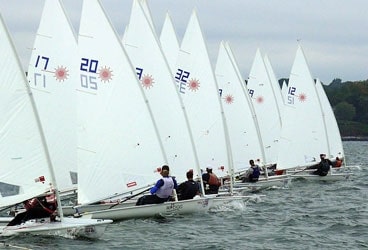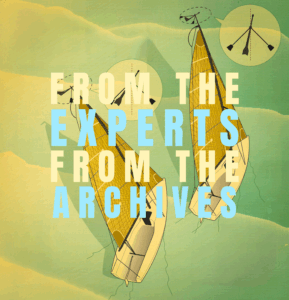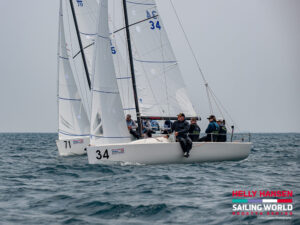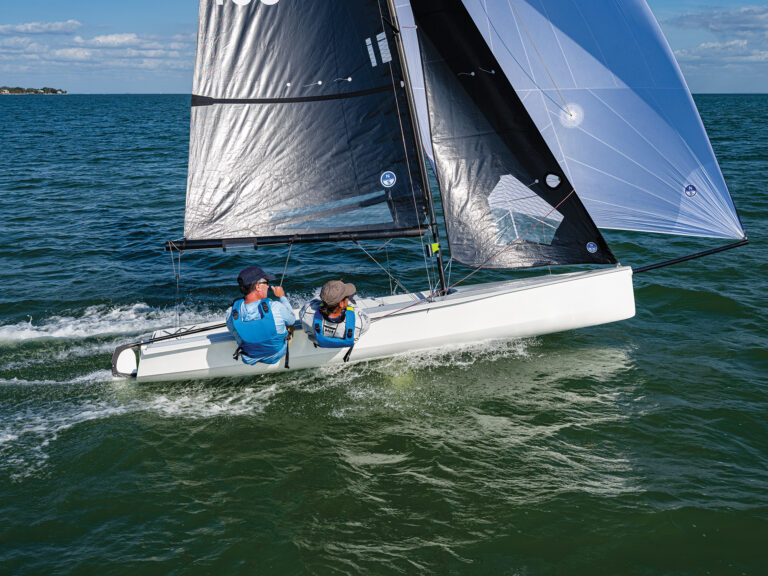
FTEDraheim368
Bruce Goldsmith was one of America’s most gifted sailors. He won Pan-American Games gold medals, world championships, and countless national championship titles. He accomplished nearly everything in the sport he set out to do, and could have accomplished so much more had he not spent much of his time teaching so many others. He died tragically this past summer at the age of 71, when he was struck on the head by the boom while helming his J/29 on Lake Erie.
As a mentor, Bruce taught me most of what I know about the sport, and only because of this am I lucky enough to have my name on a few of the same trophies that bear his. What I mostly took from him is how to prioritize the variables we encounter on the racecourse, and at the top of his list was sailing the lifted tack.
I learned this early on when I was middle crew for him while sailing the Lightning North Americans at Buffalo Canoe Club on the north shore of Lake Erie. On one particular day at the North Americans the wind was coming from the northwest–the kind of wind direction that makes racing at Buffalo Canoe Club a windshift expert’s dream. And Bruce was the windshift expert. One of my earliest Goldsmith lessons was in the making.
Bruce wanted to start near the committee boat end of the line, probably because the wind was trending to the right of the course. Still, the minute-to-minute wind direction was oscillating dramatically. With 30 or 40 seconds to go we were on starboard tack and on our final approach. Just then, the wind shifted so far left we couldn’t lay the starting line on starboard tack. When the starting gun went off, we were likely in last place. I was devastated. I started whining and forecasting our impending defeat. I figured that in a fleet of top-level sailors we were doomed. There’d be no comeback.
In typical fashion, Bruce started laughing aloud, let out a couple of humorous one-liners, and then asked me to help him find a path on port tack. We were able to do so, but some of the ducks we then had to make were massive–three or more boats at a time. On that initial port tack we were never in clear air because so much of the fleet was still ahead of us, now on port as well. But even in bad air, it was best to stay on the lift. Luckily for us, the shifts came frequently on the first beat and Bruce didn’t miss one of them. By the time we reached the first weather mark we were in third place, and if my memory serves me correctly, we went on to win the race. I was speechless.
From that moment I knew that nothing in sailboat racing is anywhere near as important as hitting the windshifts–especially the first shift. It must be done as soon as the gun goes off, not a couple of minutes into the race after sparring with the boats around you. On a less shifty day, it would have been nearly impossible to win the race, but on that day, our starting line error was irrelevant. Hitting the shifts was our only path to victory–not great steering, not great crew work, nor perfect sail adjustments. Nothing, in my opinion, comes close to the power of the windshift.
It was Bruce’s incredible course awareness that enabled him to recognize that getting to port tack immediately was the only good option–not only were we headed, but we were also caught up in a pack of boats sailing inefficiently. After a start like we had that day, many sailors develop tunnel vision and tend to pinch if they’re too close to leeward of another boat or foot if they’re close to weather of another. One must always remember that while you’re sailing your boat at less that maximum efficiency in an effort the slow the boat next to you, others in the fleet are sailing at maximum efficiency and leaving you behind. More importantly, if you’re sailing the headed tack while sparring with the boat next to you, you’re dramatically losing to the boats on the lifted tack.
So how do you immediately know whether you’re lifted or headed when the starting gun goes off? If the wind is well to the right of perpendicular to the starting line, you’ll quickly observe that starboard-tack boats are more bow-to-bow, and more perpendicular to the starting line. When the wind is well to the left of perpendicular to the starting line, boats on starboard tack will be more bow-to-stern (more parallel to the starting line) and sailing in disturbed air from the boat that’s to leeward and ahead. So getting onto port tack when the wind is coming from well to the left of perpendicular to the staring line should be done as quickly as possible, but how?
If you want to be brave, get on port tack before the start slightly underneath the fleet, find a gap between a couple of starboard-tack boats and shoot through as the gun goes off. This technique requires unbelievable time and distance abilities as well as perfect boat control, and consequently, I don’t recommend it. But if you are in the front row on starboard tack, a clearing tack should be fairly easy; just make sure you can clear the boat to weather before you tack. If you are covered up, and well behind the line like Bruce and I were in Buffalo, you can briefly wait to see if front-row starters tack right away. The disturbed air each boat is getting from the boat to leeward and ahead will stretch out the starboard tack lineup enough so you can hopefully pass through without issue. Only wait briefly, and if things don’t open up right away, tack and duck as many boats as you need to. And whatever you do, don’t tack back to starboard. Conversely, if you’re on starboard and still fighting for your chance to get to port, let any port-tack boats cross you, even if they are not quite clear ahead. The last thing you want is to have one of them tack on your leebow and give you even more dirty air.
Bruce’s lesson was very simple, but very important, and those who watched the Louis Vuitton Cup and America’s Cup sailing heard it over and over: Do whatever you can to get to the first shift. I learned this from Bruce that day in Buffalo and I’ve really never forgotten.
Editor’s Note: This is the first in a series of Draheim’s “Lessons from Bruce.” In “It’s You Against the Racecourse,” he explains how Goldsmith raced the course rather than the fleet. This article first appeared in the “Tactics” section of our September 2007 issue.









